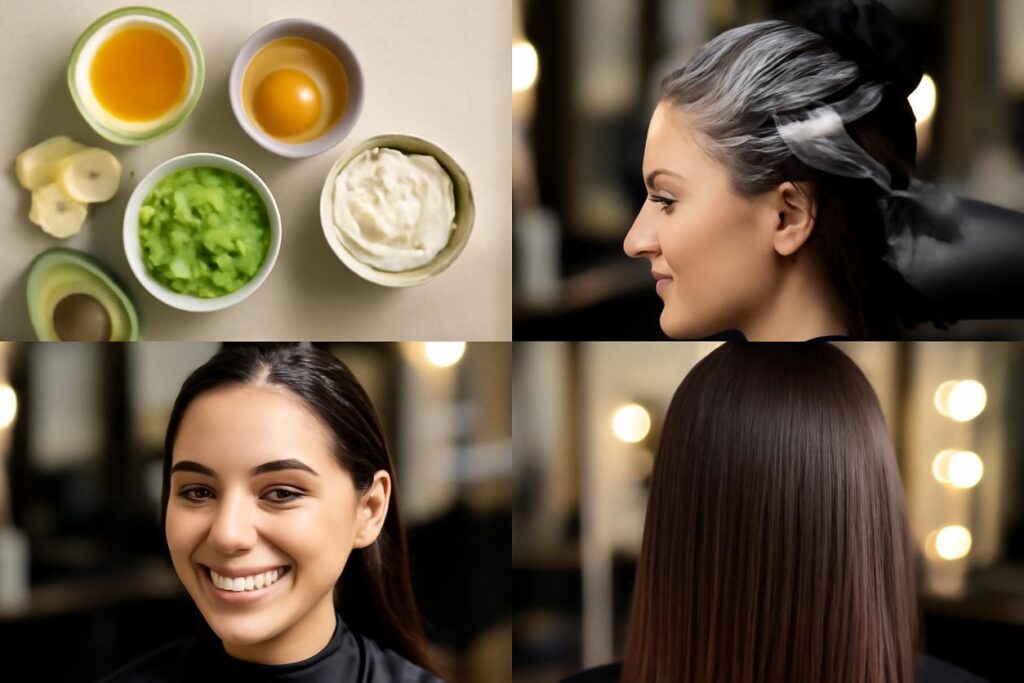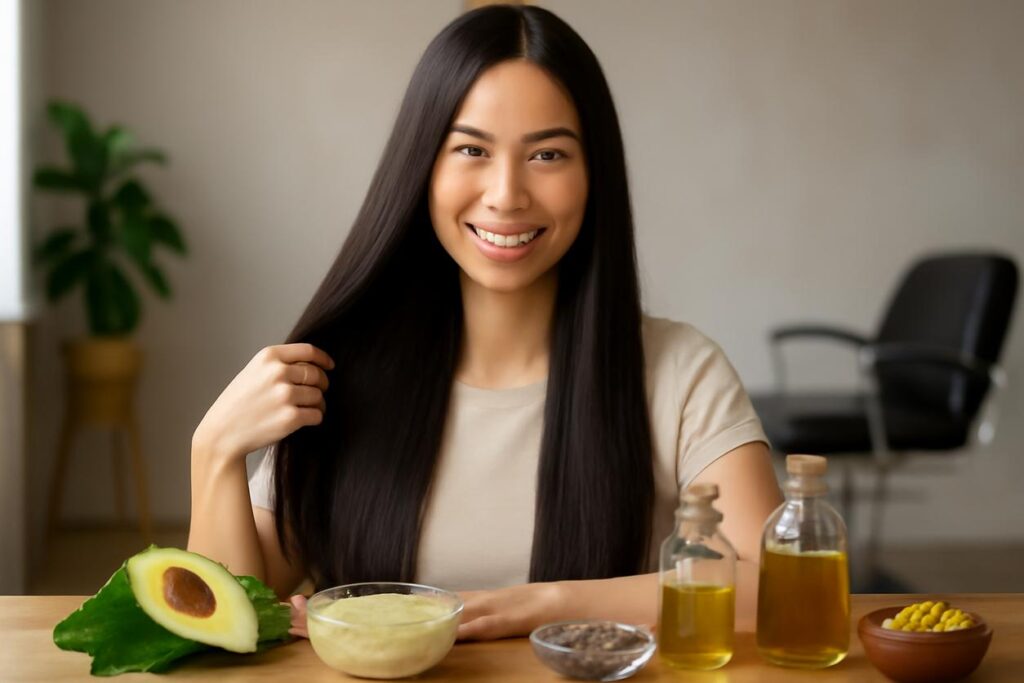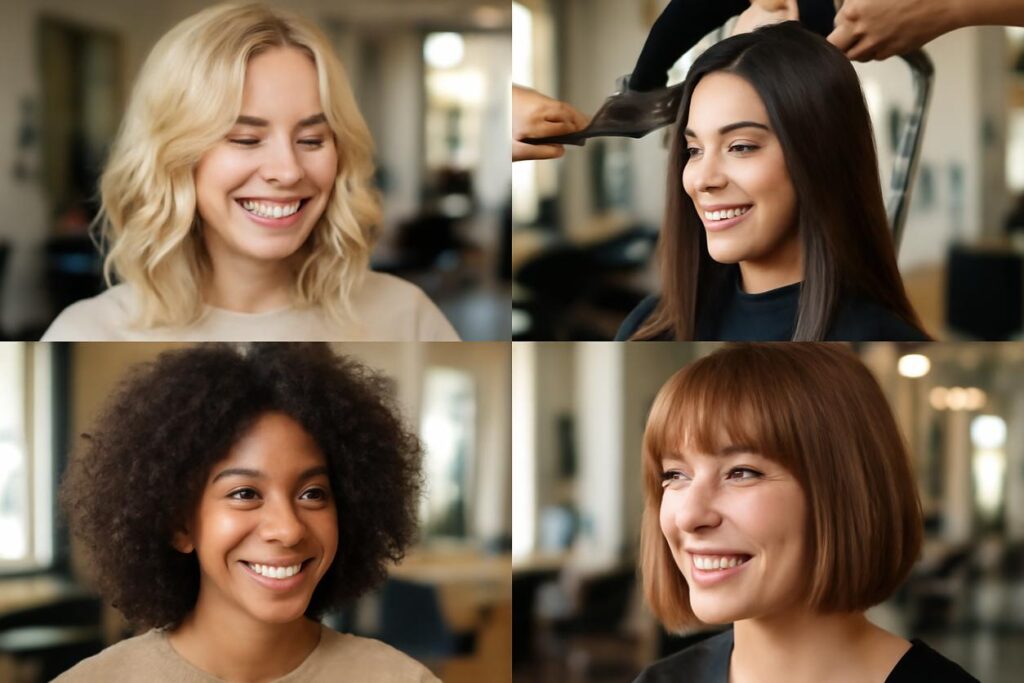Table of Contents
- Why Nutrition Matters for Curly Hair
- Key Nutrients That Support Curl Strength and Shine
- Hydration and Porosity: How Diet Influences Moisture Retention
- Meal Frameworks Matched to Curl Texture and Porosity
- Easy Recipes and Nutrient-Dense Snack Ideas
- Supplements: What the Evidence Shows and Safety Considerations
- Tracking Changes and Realistic Timelines
- When to Consult a Healthcare or Hair Specialist
- Frequently Asked Questions
- Sources and Further Reading
Why Nutrition Matters for Curly Hair
For those blessed with curls, the journey to defined, frizz-free hair often involves a bathroom cabinet filled with creams, gels, and conditioners. While topical products are essential, the true foundation of healthy hair is built from within. The concept of curly hair nutrition is not just a trend; it’s the fundamental principle that the nutrients you consume directly construct the very strands growing from your scalp. Your hair is a non-essential tissue, meaning in times of nutritional scarcity, your body will direct nutrients to vital organs first, leaving your hair to fend for itself. A consistent, nutrient-rich diet ensures there’s enough to go around, providing the essential building blocks for strong, resilient, and vibrant curls.
How Curl Structure Uses Nutrients
Curly hair is structurally unique. The hair follicle is oval-shaped, causing the strand to grow out at an angle and twist. This creates the beautiful coils and waves we love, but it also presents challenges. The twists and turns of a curl lift the hair’s outer layer, the cuticle, making it more difficult for natural scalp oils (sebum) to travel down the hair shaft. This inherent structure is why curly hair is more prone to dryness, frizz, and breakage compared to straight hair.
This is precisely where curly hair nutrition plays a critical role. Nutrients like proteins, vitamins, and minerals are the raw materials needed to:
- Strengthen the hair shaft: Protein building blocks like amino acids form keratin, the fibrous protein that makes up over 90% of your hair.
- Nourish the scalp: A healthy scalp is the garden from which your hair grows. Essential fatty acids and vitamins support scalp health and optimal sebum production.
- Promote elasticity: Proper hydration and nutrients help hair maintain its ability to stretch without breaking, a key factor in preventing damage during styling.
Key Nutrients That Support Curl Strength and Shine
To optimize your diet for curly hair, focus on a balanced intake of macronutrients (protein, fats, carbs) and micronutrients (vitamins, minerals). Think of your plate as a toolkit for building better curls.
Protein and Keratin Building Blocks
Since hair is primarily made of the protein keratin, adequate dietary protein is non-negotiable. Your body breaks down protein into amino acids, which are then used to build new proteins, including the keratin that forms your hair. Key amino acids for hair include L-cysteine and methionine.
- Excellent Sources: Lean meats (chicken, turkey), fish, eggs, dairy products (Greek yogurt, cottage cheese), legumes (lentils, chickpeas), tofu, and quinoa.
Essential Fatty Acids and Scalp Lipids
Healthy fats, particularly Omega-3 and Omega-6 fatty acids, are vital for overall health and play a direct role in hair vitality. They are incorporated into cell membranes, including those in your scalp, and are essential for producing sebum. This natural oil is your hair’s built-in conditioner, crucial for adding shine and sealing moisture into porous curls.
- Excellent Sources: Fatty fish (salmon, mackerel, sardines), flaxseeds, chia seeds, walnuts, and avocados.
Vitamins and Minerals That Matter
A variety of micronutrients support the hair growth cycle and follicle health. Deficiencies in certain vitamins and minerals are often linked to hair thinning and loss.
- Iron: Crucial for producing hemoglobin, which carries oxygen to your cells, including the hair follicles. Low iron (anemia) is a common cause of hair shedding. Find it in red meat, spinach, lentils, and fortified cereals.
- Zinc: Plays a vital role in hair tissue growth and repair. It also helps keep the oil glands around the follicles working properly. Sources include oysters, beef, pumpkin seeds, and lentils.
- Vitamin C: A powerful antioxidant that helps protect against oxidative stress. It’s also required to create collagen, a protein that strengthens hair, and it significantly improves iron absorption. Load up on citrus fruits, bell peppers, strawberries, and broccoli.
- Biotin (Vitamin B7): Famous for its role in hair health, biotin assists in the production of keratin. While deficiency is rare, ensuring adequate intake is beneficial. It’s found in eggs, nuts, seeds, and sweet potatoes.
- Vitamin E: Another antioxidant that can help prevent oxidative stress on the scalp. Find it in sunflower seeds, almonds, spinach, and avocados.
Hydration and Porosity: How Diet Influences Moisture Retention
Hydration starts from the inside out. Drinking plenty of water is the first step, but for curly hair, sealing that moisture in is the real challenge. This is where hair porosity—your hair’s ability to absorb and retain moisture—comes into play. Your diet directly impacts your body’s ability to produce the natural oils that help seal the hair cuticle.
A diet rich in essential fatty acids supports the production of sebum. For high porosity hair, which has a very open cuticle and loses moisture quickly, this is especially important. For low porosity hair, where the cuticle is tightly closed, a balanced diet ensures the sebum produced is not overly heavy, preventing buildup. Therefore, optimizing your curly hair nutrition helps your body create the perfect natural sealant for your specific hair type.
Meal Frameworks Matched to Curl Texture and Porosity
Instead of a rigid diet, use these flexible frameworks to build meals that support your unique curl needs. These simple meal strategies for 2025 and beyond focus on nutrient synergy for optimal hair health.
Quick Daily Menus for Low Porosity Curls
Low porosity hair is prone to product and oil buildup. The goal is hydration and lightweight nutrition without weighing hair down.
| Meal | Focus | Example |
|---|---|---|
| Breakfast | Light protein and hydration | Smoothie with spinach, berries, a scoop of plant-based protein powder, and water or coconut water. |
| Lunch | Lean protein and leafy greens | Large salad with grilled chicken or chickpeas, lots of vegetables, and a light vinaigrette dressing. |
| Dinner | Easily digestible protein and complex carbs | Baked cod with roasted sweet potatoes and steamed broccoli. |
| Snack | Hydrating fruits and veggies | Cucumber slices, apple slices, or a small bowl of berries. |
Quick Daily Menus for Medium Porosity Curls
This hair type has a balanced cuticle. The goal is to maintain this balance with a consistent intake of all key nutrients.
| Meal | Focus | Example |
|---|---|---|
| Breakfast | Protein and healthy fats | Scrambled eggs with a side of avocado on whole-wheat toast. |
| Lunch | Balanced macronutrients | Quinoa bowl with black beans, corn, bell peppers, and a sprinkle of pumpkin seeds. |
| Dinner | Omega-3s and antioxidants | Grilled salmon with a side of asparagus and brown rice. |
| Snack | Protein and fiber | Greek yogurt with a handful of walnuts. |
Quick Daily Menus for High Porosity Curls
High porosity hair loses moisture easily. The focus is on protein to fill in gaps in the cuticle and healthy fats to seal moisture in.
| Meal | Focus | Example |
|---|---|---|
| Breakfast | Protein-dense start | Oatmeal made with milk, topped with chia seeds, almonds, and a spoonful of nut butter. |
| Lunch | Iron and Vitamin C pairing | Lentil soup with a side of whole-grain bread and an orange. |
| Dinner | Robust protein and healthy fats | Lean beef stir-fry with a variety of colorful vegetables and a drizzle of sesame oil. |
| Snack | Sustaining fats and protein | A hard-boiled egg and a handful of almonds. |
Easy Recipes and Nutrient-Dense Snack Ideas
Incorporating curly hair nutrition into your routine doesn’t have to be complicated. Here are some simple ideas:
- Curl-Boosting Smoothie: Blend 1 cup spinach, 1/2 cup mixed berries (for Vitamin C), 1 tablespoon of flaxseed (for Omega-3s), 1 scoop of your favorite protein powder, and 1 cup of unsweetened almond milk.
- Nutrient-Dense Trail Mix: Combine walnuts, almonds, pumpkin seeds (for zinc), and a few pieces of dark chocolate for a powerful, hair-healthy snack on the go.
- Avocado and Egg Toast: Mash half an avocado onto a slice of whole-grain toast and top with a cooked egg. This snack delivers protein, healthy fats, and B vitamins.
Supplements: What the Evidence Shows and Safety Considerations
While a food-first approach is always best, supplements can be beneficial if a deficiency is identified. Biotin, iron, and zinc are commonly marketed for hair growth. However, taking supplements without a confirmed deficiency is unlikely to provide significant benefits and can sometimes be harmful.
Always consult with a healthcare provider before starting any new supplement regimen. They can order blood tests to check your levels and recommend an appropriate dosage if needed. Over-supplementing certain nutrients, like Vitamin A and selenium, can actually lead to hair loss. Rely on evidence-based sources like the research found on PubMed to understand the science behind supplementation.
Tracking Changes and Realistic Timelines
Patience is key. Hair grows about half an inch per month, so you won’t see changes overnight. It can take 3 to 6 months of consistent dietary improvements to notice a difference in the new hair growing from the scalp. Keep an eye out for subtle changes:
- Increased shine and luster.
- Improved elasticity (less snapping and breakage).
- Reduced shedding in your brush or shower.
- A healthier, more balanced scalp.
Taking a picture of your curls in the same lighting once a month can be a great way to track your progress visually.
When to Consult a Healthcare or Hair Specialist
While nutrition is a powerful tool, it’s not a cure-all. It’s important to seek professional advice if you experience:
- Sudden or excessive hair loss.
- Bald patches or significant thinning.
- A persistently itchy, flaky, or painful scalp.
- No improvement in hair health after several months of dedicated nutritional changes.
A doctor, registered dietitian, or a dermatologist can help rule out underlying medical conditions, hormonal imbalances, or other issues that could be affecting your hair.
Frequently Asked Questions
Can diet alone fix my frizzy curls?
Diet is a huge piece of the puzzle. Improving your curly hair nutrition can significantly reduce frizz by strengthening the hair shaft and improving moisture retention from within. However, it works best in combination with a proper curly hair care routine, including gentle handling, adequate moisture, and suitable styling products.
How long does it take to see results from improving my curly hair nutrition?
You may notice improvements in scalp health and hair shine within a few weeks, but for visible changes in hair strength and growth, expect to wait at least 3 to 6 months. The improvements will be seen in the new hair growing out, not the hair that is already grown.
Are there any foods I should avoid for better curls?
There are no specific foods that are universally “bad” for curls. However, a diet high in processed foods, sugar, and unhealthy fats can lead to inflammation and nutrient deficiencies, which can negatively impact hair health over time. Focus on a whole-foods-based diet for the best results.
Sources and Further Reading
For more information on building a healthy diet and understanding the science behind nutrition, explore these trusted resources:
- NHS – Healthy Eating: Comprehensive guidance on maintaining a balanced diet.
- Academy of Nutrition and Dietetics – EatRight: Evidence-based food and nutrition information from registered dietitians.
- Rich Hair UK – Resources: Further reading on hair science and health.






